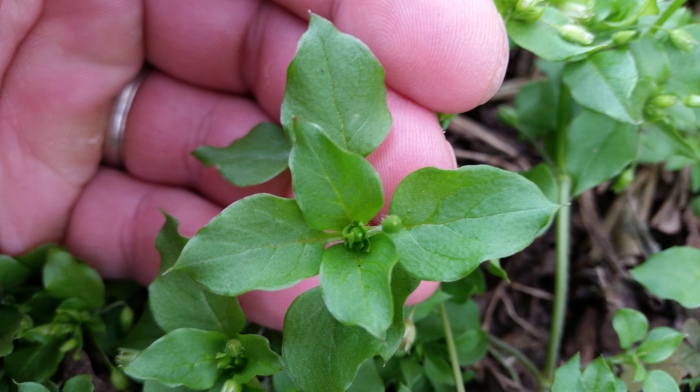 Common Chickweed is an easy wild edible to find in the late fall, and early spring. Its scientific name is Stellaria media, which means “little star in the middle.” I’d bet that’s because of the little white flower that forms in the center of the plant that resembles a star. It germinates in the winter, and it grows in clumps or patches whose tangled stems roll over areas like a mat or ground cover. Common Chickweed is indeed common, and quite edible. The leaves, flowers, stems, seed pods, and all are edible. Although it can be eaten raw, I prefer to cook it in ways you would prepare spinach. It’s a small plant, so it usually gets thrown in with other choice edibles, and cooked together.
Common Chickweed is an easy wild edible to find in the late fall, and early spring. Its scientific name is Stellaria media, which means “little star in the middle.” I’d bet that’s because of the little white flower that forms in the center of the plant that resembles a star. It germinates in the winter, and it grows in clumps or patches whose tangled stems roll over areas like a mat or ground cover. Common Chickweed is indeed common, and quite edible. The leaves, flowers, stems, seed pods, and all are edible. Although it can be eaten raw, I prefer to cook it in ways you would prepare spinach. It’s a small plant, so it usually gets thrown in with other choice edibles, and cooked together.

Chickweed growing in a clump. Notice the small white flowers, and seed pods growing at the same time on the same plant.
I would assume that it gets its common name because chicks dig it. Just kidding, its because chickens love this stuff. If you’ve got chickens in your yard, then encourage the growth of chickweed. It makes tiny seed pods, at the same time it is flowering, so it is constantly putting out very tiny seeds that chickens just can’t resist.

See the tiny seed pod. Also, note the hairs growing on only one side of the stem.
One of the identifying characteristics is that Common Chickweed will have hairs that grow only on one side of the stem. This line of hairs will change wherever a new set of leaves grows out of the stem. It will have a white flower with what appears to be 10 petals. If you look closer, it is actually 5 petals, that are double lobed on each petal, giving the appearance that the petals grow in twos. There should be no milky sap when the stem is severed.
To some Common Chickweed is considered an herb. It has been used for many years for food, as well as a folk remedy for a variety of ailments including asthma, skin problems, constipation & other stomach problems, even obesity. I don’t know if it works for any of those things, but that is what the literature says. It does apparently contain quite a bit of iron, which is good if you suffer from anemia. Others consider it a pesky weed because it tends to spring up in peoples lawns, flowerbeds, cracks in pavement, and similar places. Because it takes over the ground like a mat, and produces so many little seeds, it can be a pain to get rid of. The good news is, it tastes pretty good.
Mouse Eared Chickweed:
As I was taking pictures I came across another type of Chickweed mixed in with the Common Chickweed. It is known as Mouse Eared Chickweed (Cerastium vulgatum). The Mouse Eared Chickweed is also edible, but must be cooked. I’m not a fan, and usually stick the the more tender and succulent Common Chickweed variety.

Mouse Eared Chickweed (Cerastium vulgatum)

Common Chickweed (Stellaria media)
As you can see from the pictures, they have some similarities & some differences.
Similarities: Although the Mouse Eared Chickweed pictured is not flowering yet (they tend to flower later in the spring), they also have a 5 petaled, double lobed white flower that has the appearance of having 10 petals. They also have the same opposite oval leaf structure emanating from a central stem. They both make a tangled ground mat, and grow during similar times of year.
Differences: The most obvious difference to me is the amount of hair on the Mouse Eared Chickweed. They are covered in it. Second is the stem is completely covered in hair, and on the variety that I found today (from the Caryophyllaceae, or “pink” family), the stem has a pink hue to it.

Note the Mouse Eared Chickweed has hair everywhere, and a pinkish stem

Left: Mouse Eared Chickweed (Cerastium vulgatum) Right: Common Chickweed (Stellaria media)
AS WITH ANY OF THE INFORMATION CONTAINED ON THIS WEBSITE, DO NOT USE THE INFORMATION CONTAINED HEREIN FOR IDENTIFICATION OF ANY WILD PLANT OR OTHER MATERIAL. IT IS FOR ENTERTAINMENT PURPOSES ONLY, AND YOU SHOULD CONSULT WITH A QUALIFIED EXPERT BEFORE YOU CONSUME ANY PART OF A WILD PLANT. A MISTAKE CAN BE FATAL. DON’T BE A MORON.
Leave a comment